يناير 29, 2020 / مستشفى الشعب في مقاطعة هونان, etc. / الطب التأكسدي وطول العمر الخلوي
نص / وو تينغياو
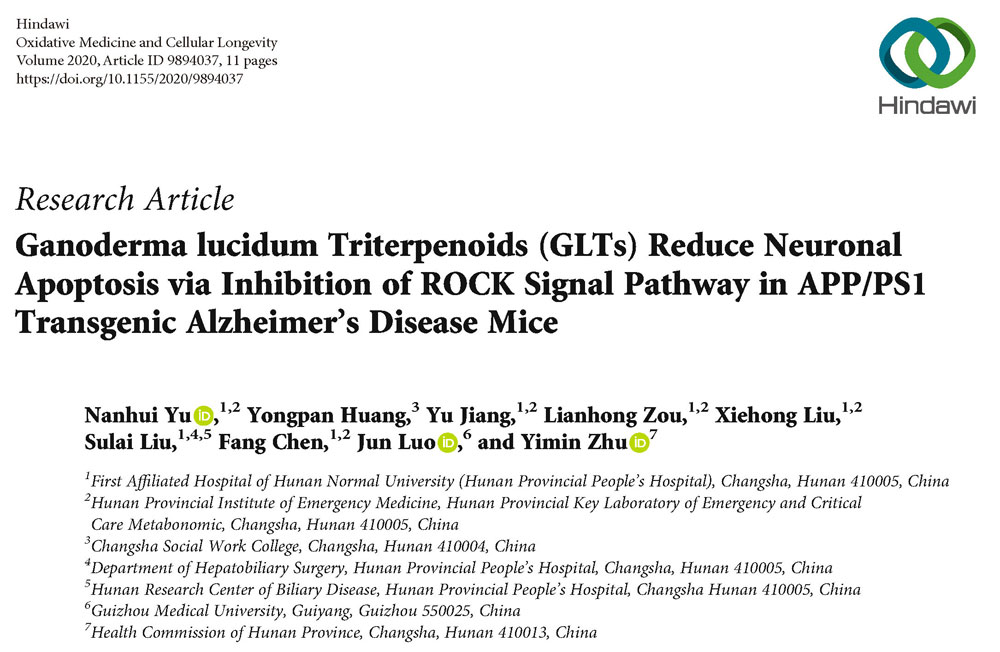
أشارت دراسة نشرت في "الطب التأكسدي وطول العمر الخلوي" من قبل مستشفى الشعب في مقاطعة هونان والمختبر الرئيسي لمقاطعة هونان للطوارئ والرعاية الحرجة الاستقلابية إلى أنغانوديرما لوكيدوم ترايتيربينويدات(خطوط طيران الخليج) يمكن أن يحمي الخلايا العصبية في الدماغ ويقلل من الضعف الإدراكي الناجم عن مرض الزهايمر (إعلان) من خلال آليات مثل مكافحة موت الخلايا المبرمج, مضاد للأكسدة, والتشابكات المضادة للليفية العصبية.
غانوديرما لوكيدوم ترايتيربينويدس يؤخر التدهور المعرفي لدى مرضى الزهايمر.
أولاً, تغذية الباحثينغانوديرما لوكيدوم ترايتيربينويدات (خطوط طيران الخليج) لمرض الزهايمر (إعلان) الفئران التي ظهرت عليها الأعراض المبكرة. بعد 60 يوما, قاموا باختبار القدرات المعرفية للفئران باستخدام متاهة موريس المائية (م.و.م).
الاستفادة من خصائص الفئران التي تكره الماء بطبيعتها وتحاول دائمًا إيجاد مكان لتجنب الماء, أجرى الباحثون متاهة موريس المائية, وهو إنشاء منصة استراحة في حوض سباحة دائري كبير لحساب المسافة التي تسبحها الفئران والوقت الذي تقضيه في العثور على منصة الراحة كمؤشرات للحكم على القدرات المعرفية للفئران. إذا كانت الفئران غير قادرة على العثور على منصة الراحة (في دقيقتين), وسيساعد الباحثون في توجيه الفئران إلى المنصة.
على الرغم من أن نقطة البداية لدخول الماء تختلف في كل مرة, لا يزال بإمكان الفئران العادية العثور بسرعة على منصة الراحة من خلال التجربة اليومية. تم إجراء مثل هذه التجربة مرة واحدة يوميًا لمدة تسعة أيام. حساب جميع الدرجات في المتوسط, ووجد الباحثون أن الفئران م (المجموعة الإعلانية) يجب أن تقضي ضعف الوقت الذي تقضيه الفئران العادية أو تسبح ثلاثة أرباع أطول (مجموعة التحكم) للعثور على منصة للراحة, مما يشير إلى أن الوظيفة الإدراكية لدماغ الفئران AD قد تدهورت بشكل كبير.
لكن, الفئران م تغذية بجرعات عالية (1.4جم/كجم يوميا) استغرقت الفئران GLT نفس الوقت تقريبًا ومسافة السباحة للعثور على منصة الراحة مثل الفئران العادية والفئران AD (مجموعة مراقبة الطب الغربي) يتغذى على دونيبيزيل كل يوم(الشكل 1~2).
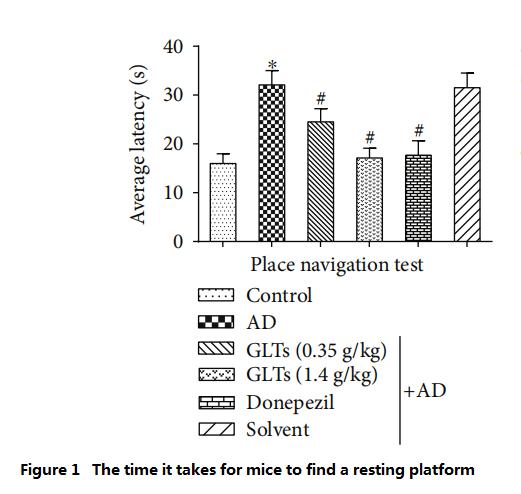
(كلما قل الوقت المطلوب, كلما كانت القدرة المعرفية أفضل)
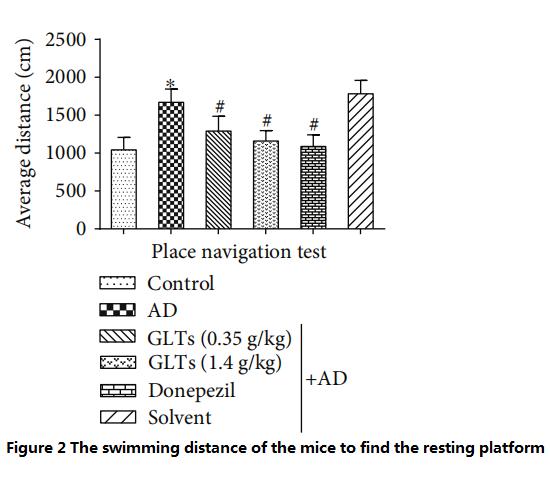
(كلما قلت المسافة المطلوبة, كلما كانت القدرة المعرفية أفضل)
في اليوم التالي بعد انتهاء التجربة المذكورة أعلاه, أزال الباحثون منصة الاستراحة في حوض السباحة ووضعوا الفئران في الماء لمدة دقيقتين.
نظرا للأيام التسعة السابقة من الخبرة, تذكرت الفئران العادية الموقع الأصلي للمنصة وأمضت المزيد من الوقت في السباحة حول الموقع الأصلي للبحث عن "المنصة المختفية" بينما سبحت الفئران المصابة بالزهايمر بلا هدف.
في المقابل, تصرفت الفئران المصابة بالزهايمر والمحمية بواسطة GLTs مثل الفئران العادية سواء عند تناول جرعات منخفضة (0.35 جم/كجم يوميا) أو بجرعات عالية (1.4 جم/كجم يوميا) وسجلت تقريبًا نفس النتائج التي سجلتها الفئران التي تم تغذيتها بالطب الغربي (أرقام 3 ل 4).
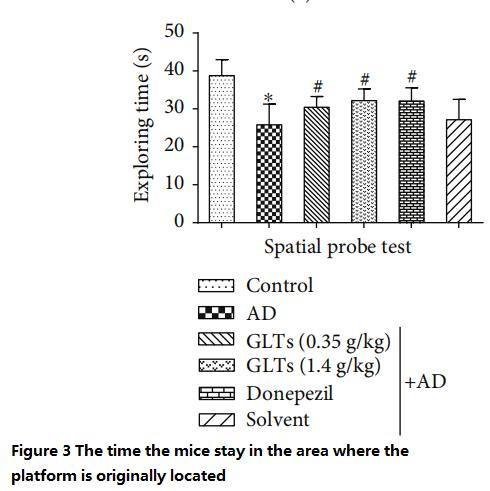
(كلما طالت فترة الإقامة, كلما كانت القدرة المعرفية أفضل)
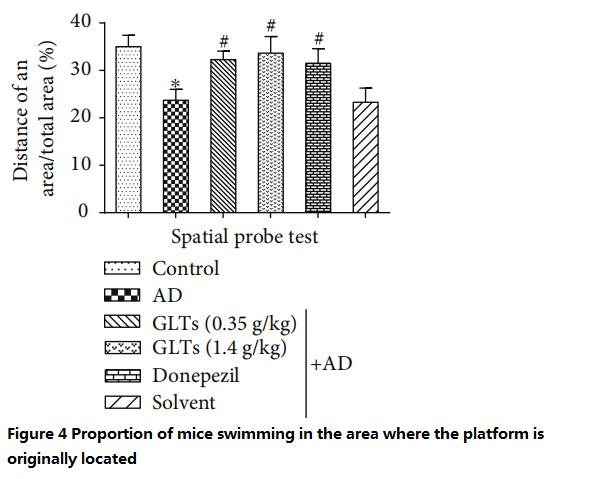
(كلما ارتفعت النسبة, كلما كانت القدرة المعرفية أفضل)
غانوديرما لوكيدوم تحافظ ترايتيربينويدات على سلامة الخلايا العصبية.
انخفاض القدرة على التعلم والذاكرة هو أول انخفاض في الوظيفة الإدراكية (اضطراب) في المرضى الذين يعانون من مرض الزهايمر, وتقع الخلايا العصبية المسؤولة عن هذه الوظيفة في التلفيف الحصين. لذلك, بعد أن أكمل الباحثون التجارب المذكورة أعلاه, قاموا بتشريح دماغ الفأر لمزيد من الفحص.
وأظهرت النتائج أن الخلايا العصبية في التلفيف الحصيني لدى الفئران العادية مرتبة بشكل أنيق, موحدة في الحجم, منتظم في المظهر, ويتم ترسيم حدود أغشية الخلايا ونواتها بشكل واضح; يتم ترتيب الخلايا العصبية في التلفيف الحصين لدى الفئران AD بشكل غير منظم, مختلفة في الأحجام, غير منتظم في المظهر, انخفض بشكل كبير في العدد, ومن الواضح أن هيكلها تالف.
لكن, لم يظهر هذا الوضع في الفئران التي تستهلك غانوديرما لوكيدوم ترايتيربينويدس. لا تزال الخلايا العصبية الموجودة في التلفيف الحصيني تحافظ على درجة عالية من التكامل, ولم يكن هناك نخر واضح للخلايا, مشيرا إلى ذلكغانوديرما لوكيدوم كان للترايتيربينويدات تأثير وقائي على التلفيف الحصين ( شكل 5).
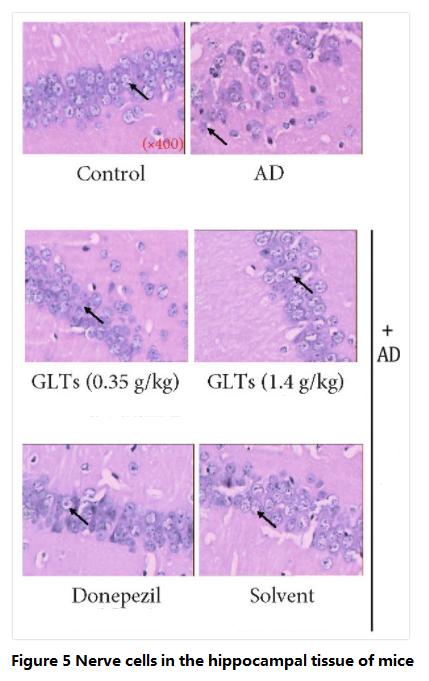
غانوديرما لوكيدوم ترايتيربينويدس يقلل من التشابك الليفي العصبي.
في نفس الوقت, كما وجد الباحثون أن عدد التشابكات الليفية العصبية في القشرة الدماغية (تخزين الذاكرة طويلة المدى) وأنسجة التلفيف الحصين في الفئران م المحمية بواسطةغانوديرما لوكيدوم وكان ترايتيربينويدات أقل بكثير من تلك الموجودة في الفئران م غير المعالجة (شكل 6).
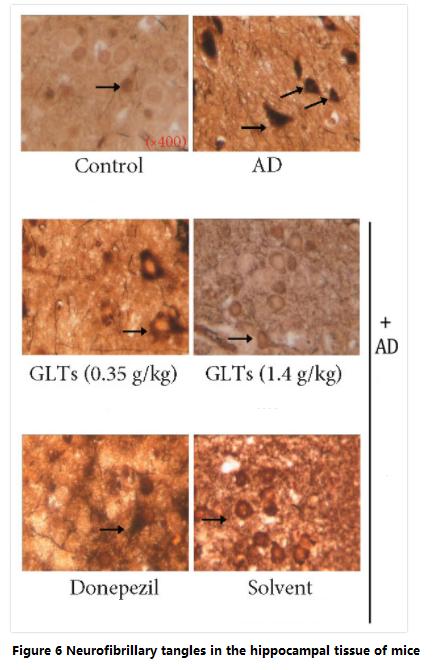
التشابكات الليفية العصبية هي أحد الأعراض الرئيسية لمرض الزهايمر. على عكس رواسب الأميلويد التي تحدث خارج الخلايا, تحدث التشابكات الليفية العصبية في الخلايا العصبية بسبب طفرة "بروتين تاو".
في ظل الظروف العادية, يرتبط بروتين تاو بالهيكل الخلوي (الأنابيب الدقيقة) للمساعدة في تكوين واستقرار الهيكل الخلوي. لكن, سوف يتحور بروتين تاو الموجود في دماغ مرضى الزهايمر ولا يمكنه الارتباط بالهيكل الخلوي. نتيجة ل, سوف يتجمع بروتين تاو في مجموعات لتكوين ما يسمى "التشابك الليفي العصبي", التي تتراكم في الخلايا وتتداخل مع وظيفة الخلايا. سوف يصبح الهيكل الخلوي الذي يفتقر إلى بروتين تاو مشوهًا ومتفككًا تدريجيًا, مما يؤدي إلى موت الخلايا.
ويعكس عدد التشابكات الليفية العصبية درجة تدهور مرض الزهايمر. لذلك, غانوديرما لوكيدوم ترايتيربينويدس يمكن أن يمنع تكوين التشابك الليفي العصبي, والتي ينبغي أن تكون واحدة من الآليات الهامة لغانوديرما لوكيدوم ترايتيربينويدس لتأخير التدهور المعرفي في مرض الزهايمر.
غانوديرما لوكيدوم ترايتيربينويدس يقلل من موت الخلايا المبرمج للخلايا العصبية.
إما ترسيب بيتا أميلويد أو التشابك الليفي العصبي سيبدأ البرنامج الانتحاري للخلية ويعزز موت الخلايا المبرمج للخلايا العصبية. كلما تموت المزيد من الخلايا العصبية, يتم فقدان المزيد من الوظائف, ويصبح التدهور المعرفي الناجم عن مرض الزهايمر أكثر خطورة.
من تحليل أنسجة التلفيف الحصين لكل مجموعة من الفئران التجريبية, وقد وجد أن معدل موت الخلايا العصبية في الفئران المصابة بمرض الزهايمر يزيد عن أربعة أضعاف معدل موت الخلايا العصبية في الفئران العادية من نفس العمر; على الرغم من جرعة عاليةالجانوديرماواضح لا يمكن للترايتيربينويدات أن تمنع بشكل كامل موت الخلايا المبرمج غير الطبيعي للخلايا العصبية, لقد تمكنوا من خفض الضرر إلى النصف, وتأثيره مشابه لتأثير الطب الغربي (شكل 7).
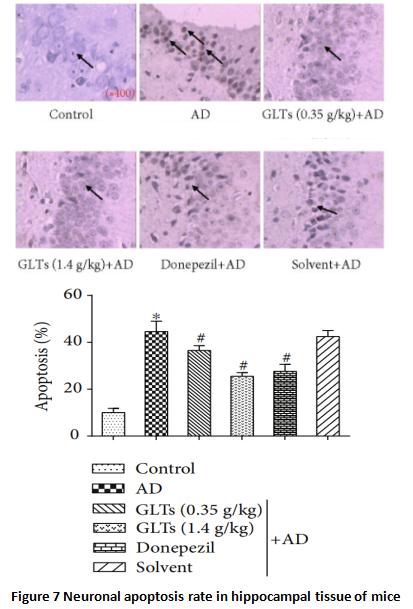
وقام الباحثون بتحليل كذلك ووجدوا أنه في الفئران م التي تحتفظ بهاغانوديرما لوكيدوم ترايتيربينويدات, تتمتع الخلايا العصبية في الدماغ بآلية قوية مضادة للأكسدة لمكافحة الضرر التأكسدي الناجم عن بروتين β-أميلويد ولا يتم تنشيط آلية موت الخلايا المبرمج بسهولة. بعبارة أخرى, غانوديرما لوكيدوم ترايتيربين يقوي مقاومة الإجهاد للخلايا العصبية في الدماغ, مما يجعلها أكثر قدرة على البقاء والعمل في بيئة قاسية.
غانوديرما لوكيدوم السكريات مفيدة أيضًا.
وتظهر نتائج البحوث المذكورة أعلاه ذلكغانوديرما لوكيدوم ترايتيربينويدات, بعد دخول الجهاز الهضمي عن طريق المريء, يمكن أن يبطئ تطور مرض الزهايمر من خلال مضادات الأكسدة, مكافحة موت الخلايا المبرمج, والتشابكات المضادة للليفية العصبية.
في الحقيقة, تأثيرغانوديرما لوكيدوم السكريات ليست أضعف من تلك الموجودة في غانوديرما لوكيدوم ترايتيربينويدس. في 2017, أثبتت دراسة نشرت بشكل مشترك في "تقارير الخلايا الجذعية" من قبل جامعة تونغجي والأكاديمية الصينية للعلوم أن الصيانة طويلة الأمد معغانوديرما لوكيدوم مستخلص الماء أوغانوديرما لوكيدوم يمكن أن تقلل السكريات من رواسب الأميلويد بيتا في أدمغة الفئران المصابة بمرض الزهايمر, تساعد على تكاثر الخلايا العصبية في التلفيف الحصيني وتبطئ تراجع التعلم والذاكرة. (للحصول على التفاصيل, يرى: غانوديرما لوكيدوم عديد السكاريدق الحد من التدهور المعرفي الناجم عن مرض الزهايمر)
غانوديرما لوكيدوم ترايتيربينويدس وغانوديرما لوكيدوم يبدو أن السكريات لها تأثيرات مختلفة في حماية الدماغ من مرض الزهايمر. هل يمكن للتأثير المشترك للاثنين أن يبطئ تطور مرض الزهايمر?
بمجرد حدوث مرض الزهايمر, فمن الصعب عكس ذلك. لكن, إذا تمكنا من الاحتفاظ بمزيد من القدرات المعرفية, بما في ذلك التعلم والذاكرة, في حياتنا المحدودة, قد تكون لدينا فرصة للتحسن مع مرض الزهايمر.
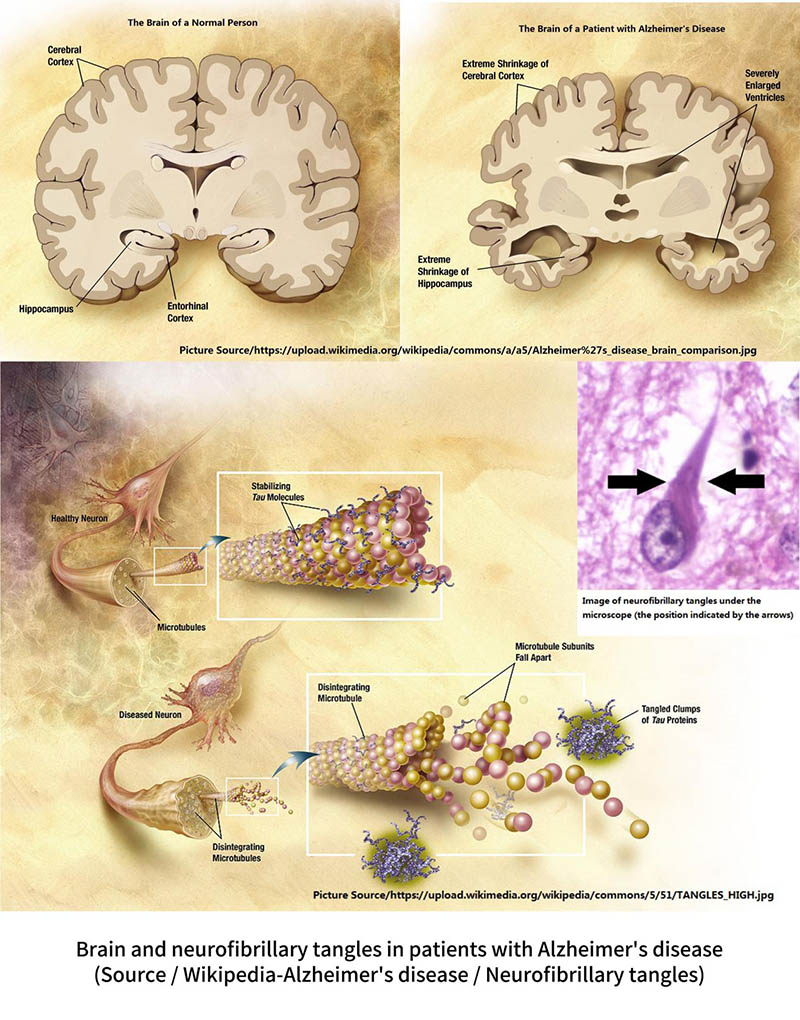
مصدر
1. يو ن, وآخرون. غانوديرما لوكيدوم ترايتيربينويدس (خطوط طيران الخليج) تقليل موت الخلايا المبرمج للخلايا العصبية عن طريق تثبيط مسار إشارة ROCK في فئران مرض الزهايمر المعدلة وراثيا APP/PS1. أكسيد مع خلية Longev. 2020; 2020: 9894037.
2. هوانغ س, وآخرون. السكريات من غانوديرما لوكيدوم تعزيز الوظيفة الإدراكية وتكاثر السلف العصبي في نموذج الفأر لمرض الزهايمر. تقارير الخلايا الجذعية. 2017 يناير 10;8(1):84-94. دوي: 10.1016/j.stemcr.2016.12.007.
نهاية
نبذة عن الكاتبة/ م. وو تينغياو
قام وو تينغ ياو بتقديم تقارير مباشرةغانوديرما لوكيدوم المعلومات منذ ذلك الحين 1999. هي مؤلفةالشفاء بالجانوديرما (نشرت في دار النشر الطبية الشعبية في أبريل 2017).
★ يتم نشر هذه المقالة بموجب التفويض الحصري للمؤلف
★ لا يمكن إعادة إنتاج الأعمال المذكورة أعلاه, مقتطفة أو مستخدمة بطرق أخرى دون إذن المؤلف
★ مخالفة البيان أعلاه, سوف يتابع المؤلف مسؤولياته القانونية ذات الصلة
★ تمت كتابة النص الأصلي لهذه المقالة باللغة الصينية بواسطة Wu Tingyao وترجمها إلى الإنجليزية بواسطة Alfred Liu. إذا كان هناك أي اختلاف بين الترجمة (إنجليزي) والأصل (الصينية), يجب أن تسود الصينية الأصلية. إذا كان لدى القراء أي أسئلة, يرجى الاتصال بالمؤلف الأصلي, آنسة. وو تينغياو.



